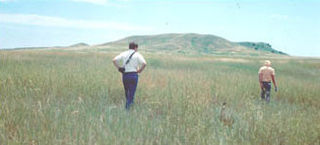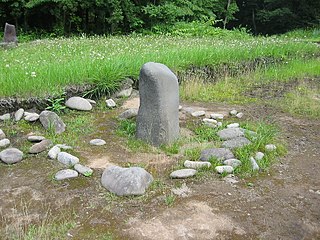
The Piegan are an Algonquian-speaking people from the North American Great Plains. They were the largest of three Blackfoot-speaking groups that made up the Blackfoot Confederacy; the Siksika and Kainai were the others. The Piegan dominated much of the northern Great Plains during the nineteenth century.

A tipi, often called a lodge in English, is a conical tent, historically made of animal hides or pelts, and in more recent generations of canvas, stretched on a framework of wooden poles. The word is Siouan, and in use in Dakhótiyapi, Lakȟótiyapi, and as a loanword in US and Canadian English, where it is sometimes spelled phonetically as teepee and tepee.

Historically, most medicine wheels follow a similar pattern of a central circle or cluster of stones, surrounded by an outer ring of stones, along with "spokes" radiating from the center out to the surrounding ring. Often, but not always, the spokes may be aligned to the cardinal directions. In other cases, some stones may be aligned with astronomical phenomena. These stone structures may be called "medicine wheels" by the Indigenous nation which built them, or by more specific names in that nation's language.

Nose Hill Park is a natural park in the northwest quadrant of Calgary, Alberta which covers over 11 km2 (4.2 sq mi). It is the fourth-largest urban park in Canada, and one of the largest urban parks in North America. It is a municipal park, unlike Fish Creek, which is a provincial park. It was created in 1980.

Writing-on-Stone Provincial Park is located about 100 kilometres (60 mi) southeast of Lethbridge, Alberta, Canada, or 44 kilometres (30 mi) east of the community of Milk River, and straddles the Milk River itself. It is one of the largest areas of protected prairie in the Alberta park system, and serves as both a nature preserve and protection for many First Nations (indigenous) rock carvings and paintings. The park is sacred to the Blackfoot and many other aboriginal tribes.
Carmangay is a village in southern Alberta, Canada. It is located 62 kilometres (39 mi) north of Lethbridge and 150 kilometres (93 mi) south of Calgary, along the Canadian Pacific Railway, east of Highway 23. It takes its name from C.W. Carman, who bought 1,500 acres (6.1 km2) at $3.50 per acre to grow wheat in 1904, and his wife, Gertrude Gay.

This is a list of properties and historic districts in Missouri on the National Register of Historic Places. There are NRHP listings in all of Missouri's 114 counties and the one independent city of St. Louis.
Alice Beck Kehoe is a feminist anthropologist and archaeologist. She has done considerable field research among Native American peoples in the upper plains of the US and Canada, and has authored research volumes on Native American archaeology and Native American history. She is also the author of several general anthropology and archaeology textbooks.

The archaeology of Iowa is the study of the buried remains of human culture within the U.S. state of Iowa from the earliest prehistoric through the late historic periods. When the American Indians first arrived in what is now Iowa more than 13,000 years ago, they were hunters and gatherers living in a Pleistocene glacial landscape. By the time European explorers visited Iowa, American Indians were largely settled farmers with complex economic, social, and political systems. This transformation happened gradually. During the Archaic period American Indians adapted to local environments and ecosystems, slowly becoming more sedentary as populations increased. More than 3,000 years ago, during the Late Archaic period, American Indians in Iowa began utilizing domesticated plants. The subsequent Woodland period saw an increase on the reliance on agriculture and social complexity, with increased use of mounds, ceramics, and specialized subsistence. During the Late Prehistoric period increased use of maize and social changes led to social flourishing and nucleated settlements. The arrival of European trade goods and diseases in the Protohistoric period led to dramatic population shifts and economic and social upheaval, with the arrival of new tribes and early European explorers and traders. During the Historical period European traders and American Indians in Iowa gave way to American settlers and Iowa was transformed into an agricultural state.

The Langdeau Site, designated by the Smithsonian trinomial 39LM209, is an archaeological site in Lyman County, South Dakota, near Lower Brule. It was declared a National Historic Landmark in 1964. The site was one of the first to provide evidence of horticultural activity by Native Americans in the region.
The Basin Oil Field Tipi Rings were first noted during a cultural resource inventory along a coal slurry pipeline route. Located near the confluence of Caballo Creek and the Belle Fourche River in northeastern Wyoming, the site primarily represents a Middle Missouri encampment in the Late Prehistoric or Protohistoric periods. The site may also have been occupied in the Late Archaic period. The middle Missouri tradition includes elements of the Mandan, Hidatsa and Crow.

First Peoples Buffalo Jump State Park is a Montana state park and National Historic Landmark in Cascade County, Montana in the United States. The park is 1,481 acres (599 ha) and sits at an elevation of 3,773 feet (1,150 m). It is located about 3.5 miles (5.6 km) northwest of the small town of Ulm, which is near the city of Great Falls. First Peoples Buffalo Jump State Park contains the Ulm Pishkun, a historic buffalo jump utilized by the Native American tribes of North America. It has been described as, geographically speaking, either North America's largest buffalo jump or the world's largest. There is some evidence that it was the most utilized buffalo jump in the world. The site was added to the National Register of Historic Places on December 17, 1974, and designated a National Historic Landmark in August 2015. The former name of the park was derived from the Blackfeet word "Pis'kun," meaning "deep kettle of blood," and the nearby town of Ulm.

Franktown Cave is located 25 miles south of Denver, Colorado on the north edge of the Palmer Divide. It is the largest rock shelter documented on the Palmer Divide, which contains artifacts from many prehistoric cultures. Prehistoric hunter-gatherers occupied Franktown Cave intermittently for 8000 years beginning about 6400 B.C. The site held remarkable lithic and ceramic artifacts, but it is better known for its perishable artifacts, including animal hides, wood, fiber and corn. Material goods were produced for their comfort, task-simplification and religious celebration. There is evidence of the site being a campsite or dwelling as recent as AD 1725.

The following outline is provided as an overview of and topical guide to the prehistoric people of Colorado, which covers the period of when Native Americans lived in Colorado prior to contact with the Domínguez–Escalante expedition in 1776. People's lifestyles included nomadic hunter-gathering, semi-permanent village dwelling, and residing in pueblos.
The Apishapa culture, or Apishapa Phase, a prehistoric culture from 1000 to 1400, was named based upon an archaeological site in the Lower Apishapa canyon in Colorado. The Apishapa River, a tributary of the Arkansas River, formed the Apishapa canyon. In 1976, there were 68 Apishapa sites on the Chaquaqua Plateau in southeastern Colorado.

Archaeology in Saskatchewan, Canada, is supported by professional and amateur interest, privately funded and not-for-profit organizations, and governmental and citizen co-operation with the primary incentive to encourage archaeological awareness and interest in the heritage that defines the province to this date. The landscape of Saskatchewan hosts substantial prehistoric and historic sites.
The Edwards Archaeological Site is an archaeological site in Beckham County, Oklahoma, near the town of Carter. The site is part of the Edwards Complex, a culture which flourished in this area from about 1400 to 1650. The site was a Native American (Indian) village and included dwellings surrounded by a round fortification. Large amounts of waste material, such as tools and bones, have been collected from the site, indicating prolonged inhabitation by a large group. Pottery fragments and obsidian and turquoise artifacts found at the site suggest that its inhabitants traded with Puebloan peoples.
The Indian Mountain Site is an archaeological site near Lyons, Colorado.

The Komakino Site is an archaeological site located in the city of Aomori, Aomori Prefecture, in the Tōhoku region of northern Japan containing the ruins of a late Jōmon period settlement. The remains were designated a National Historic Site in 1995 by the Japanese government. The site is located a short distance to the south of the famous Sannai-Maruyama Site.
The Plains Village period or the Plains Village tradition is an archaeological period on the Great Plains from North Dakota down to Texas, spanning approximately 900/950 to 1780/1850 CE.












